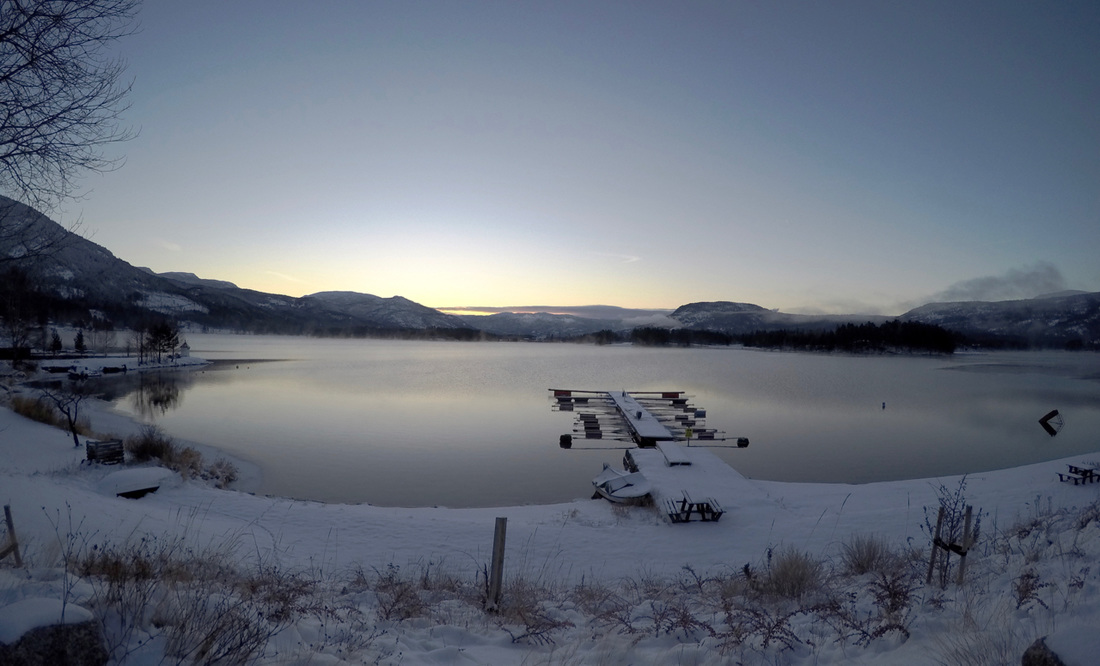|
After competing in Norway the weekend before last, we traveled back down to Europe and a week of training in Slovenia. Although we’re all anxious to get back to competing on the World Cup circuit, this week of training turned out to be really productive. This weekend we start back up with the first World Cup of the New Year in Chaux-Neuve France! Planica is one of my favorite places to train. We were there for a camp this fall and it was great to get back on the jumps on snow. They're modern and somewhat challenging hills, but the super smooth inruns and high flying profiles make them some of my favorite hills to jump. It’s pretty sweet to wake up in the morning and have the choice of two hills (K95 and K125) just right up the valley. Winter still hasn’t fully hit Slovenia yet, but fortunately they had enough snow made for a challenging loop of skiing. By the end of the week I had close to 95km – some 50 laps – on the loop. Surprisingly, most of the sessions went by pretty quickly. It helps to have a specific plan to break up and focus the session. The Cross Country World Cup happened to be in Planica for a sprint weekend while we were there. On Saturday and Sunday we went right from jumping to the race course and watched the action from the sidelines. The races were high paced and really exciting to spectate. It was cool to get a good perspective on how fast those top sprinters are – especially before we skied our own race on the course after them. We just did a small “practice” comp to keep the speed up, but I gained a real appreciation for how much speed the cross country athletes carried on their sprints on the same tracks. I put up a quick video that my coach shot in some of our interval sessions. Some pics from the XC spectating: We also ran into some of our own cross country skiers in the weight room on Monday. Periodically throughout the winter our World Cups are held with them, and other times, like this, we happen to just be in the same place at the same time. (Although usually if it's not for a competition, we run into other US Ski Team athletes at the airport hotel in Germany). Yesterday we traveled to France - across Italy, over a corner of Switzerland, and just out of the French Alps to the city of Pontarlier, France. The scenery through the Alps, north of Torino and between Chamonix and Zermatt, was spectacular. Nothing makes an 8-hour drive go by like a couple hours in some of the coolest mountains around. Pontarlier is a surprisingly large city about 45 minutes away from the small town of Chaux-Neuve, where we’ll compete. This competition was originally scheduled for the last weekend, and after it was pushed back, the organizers had to scramble to find new accommodations for all of the teams. Most of the area surrounding Chaux-Neuve is farmland dotted with small rural towns, so I’m not shocked that this was the closest city they could find with open rooms. I’m psyched to get this weekend going tomorrow with official training and PCR/qualification. The next two weekends are pretty high pressure, as we need to get some more points in order to keep the rest of the season alive. But last year I had my best result here in Chaux-Neuve, and I think I’m up for the challenge!
You can read more on the current status of our team and startrights from this recent FasterSkier article: http://fasterskier.com/blog/article/for-u-s-nordic-combined-quota-spots-and-more-on-the-line-as-world-cup-restarts/
0 Comments
In case you missed it, FIS gave me the opportunity to share some writing. The following post is also on their website. http://www.fis-ski.com/nordic-combined/news-multimedia/news/article=unpredictabilty-adam-loomis.html Also, I made a little video from our trip up to Norway. You may need to watch it on a desktop if it does not play on mobile. FIS Guest Blog: UnpredictabilityDue to the very difficult weather situation that brings a long competition break this winter, FIS Nordic Combined is breaking new ground on its website, usually dedicated to competition reports, news and interviews with the top stars. Instead of asking about sports related matters, we gave the word to our athletes themselves: what is on their minds at the moment, how do they view and handle the situation and related "deeper" issues like positivity, the spirit of competition or climate change? In the first edition, Team USA's Adam Loomis writes about unpredictability.
If I’ve learned one thing so far this season, it’s that nothing is predictable. We saw this the first weekend of the circuit, in Ruka, Finland. We arrived early in the week to find perfect wintery conditions: plenty of snow, cold temps, and calm winds. By the weekend, however, a warm front blew in – and kept blowing. The strong winds prevailed, preventing even a single round of training, much less the completion of a full jump competition. In Lillehammer, the next stop, and the defacto season opener, after one competition on the big hill, we moved down to the normal hill. This meant a quick change to a very different hill, and those that were ready for this excelled. Fast forward two weekends to Ramsau, where the prodigy Norwegian Jarl Magnus Riiber stole the spotlight of both competitions. While we first saw Riiber’s talent in full form last winter, his performance in Ramsau brought fresh light to how high the level of jumping can be on the Nordic Combined circuit. Despite his dominance on the jump hill, through four separate competitions, we’ve had four different athletes at the top of the World Cup podium. Thus far in 2016, challenging conditions and schedule changes have been the unfortunate story. Athletes and coaches found themselves making quick adjustments to their plans, searching for the places with good snow for training, such as Seefeld, Austria. Back in the US, we were lucky to have incredible winter conditions for training in Park City, UT. After the announcement about Schonach, our “younger” World Cup team (Jasper Good, Ben Berend, Michael Ward and me) flew to Munich, rather than change our tickets for a second time. From Munich, we pushed onward to Høydalsmo, Norway. (9 hours of driving through Germany, one night at a hotel, three more hours to the tip of Denmark, a “short” 4 hour ferry ride to Larvik, Norway, and then three more hours to our hotel). Høydalsmo held a Continental Cup – as planned – but now without a World Cup that weekend, it got a whole lot harder. Numerous World Cup athletes were amongst the 67 starters, including Finland’s Ilkka Herola, who already has a podium this season from Lillehammer, and Maxime Laheurte, a French veteran of the sport with multiple podiums. These two athletes in particular seemed likely to take the competition by storm, but as it turned out, only Maxime reached the podium, with a third place on Saturday. It is evident that one cannot take anything for granted in this sport. Plans will change, upsets are the norm, and there’s no guarantee that a so-called “World Cup athlete” will always beat a Conti Cup skier. On a personal level, I started the weekend with relatively strong jump performances, but after a disappointing race on Saturday, I struggled to bring the same mindset into Sunday’s competition. Rather than be psyched about my improvements on the jump hill, I lingered for too long upon failing to meet my expectations for the race. In hindsight, I should have known that everything fluctuates, from year-to-year, week-to-week and day-to-day. Rather than worry about the factors that aren’t going as planned, we can all be better by appreciating what we have going well for us. Take the winner of the second day in Høydalsmo, Franz-Josef Rehrl for example. Last winter in Høydalsmo the jump competition was cancelled due to too much snow (yes that can happen). Fortunately, we still had a provisional jump to use for the afternoon’s race. Franz, however, took the extra time waiting at the jump hill as an opportunity to go powder skiing behind the ski jumps. He came back into the changing room some time later, fully covered in snow, grinning and, luckily, with his 2.6m long jump skis still in good shape. While I’m not prescribing this as a pre-race routine, it says something about a skill that winners have. They adapt and make the best of what is in front of them. This winter may or may not become the norm for years to come. But certainly, as athletes, we will only have to get more accustomed to varying conditions and changing schedules. At the end of the day, anytime we get a big group of Nordic Combined skiers together; it makes for a great competition. When you let go of the bar, or charge into the start of the race, it doesn’t matter where you are, or what it’s called. The opportunity to compete is a beautiful thing. |
Where am I?
|
















